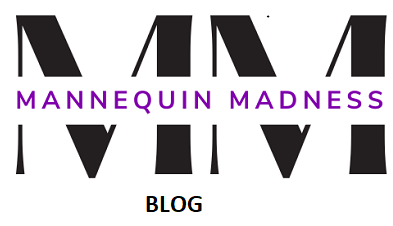A store window display is the scene you create in your exterior facing windows and one of the most powerful elements in your merchandising arsenal. Your window displays are an instrument for bringing in new and existing customers, displaying new products, highlighting promotions, and enhancing your brand image.

Ultimately, an effective store window display drives sales. A study from the National Purchase Diary Research group found that window displays influence purchases 24% of the time. And, according to the U.S. Census Bureau, even with a rise in ecommerce shopping, in 2021 86.6% of US retail sales still take place in-store.
Creating window displays will be a major part of starting your retail store, and this guide will give you the tools to design something that will pack a punch and help you grow. Here’s how to create a window display in four steps:
1. Start With a Story or Theme
Before you begin setting up your display, it is best to determine the story you want your window to tell. Having a set story will help make your window display cohesive and understandable to customers, and it will help guide you through the creation process. Keith Quesenberry, a professor of marketing, has written extensively about storytelling and how it is among the most powerful strategic business tools for growing your brand and appealing to customers.
Did You Know?
According to research by Headstream, “If people love a brand story, 55% are more likely to buy the product in future, 44% will share the story, and 15% will buy the product immediately.”
To ensure that your story is told well, follow these guidelines:
Stick to a Color Palette
One of the most significant ways you will convey your story to customers is through color. Color has strong psychological effects on human perception, and you should be sure that the colors you choose are in line with the story you want to tell.
For example, red triggers feelings of excitement, passion, danger, energy, and action and would work well in window displays that are conveying stories about love or exercise. Meanwhile, green is associated with peace, growth, and healing and would be better suited for window displays telling stories of vacation or nature. Reference the color wheel below for more on the sentiments invoked by different colors and hues:
This color wheel shows the emotions that different colors illicit.
In addition to choosing colors that create emotional responses that are in line with your story, you also want to be sure you are limiting the number of colors you use. Too many colors will create a sense of chaos and disorder and can blur your story. I recommend sticking to two or three colors in your display to avoid creating confusion.
A tropical-inspired window display uses green and orange hues. (Source: Planarama.com)
You can, however, create more colorful displays by sticking to a color family (say, reds, pinks, and purples), by maintaining a consistent color tone (think pastels or primary colors), or by using many different shades of the same color (maybe teal, hunter green, and olive). The key is cohesiveness, so you want to be sure that the colors you choose work well together and do not clash and create a sense of disarray.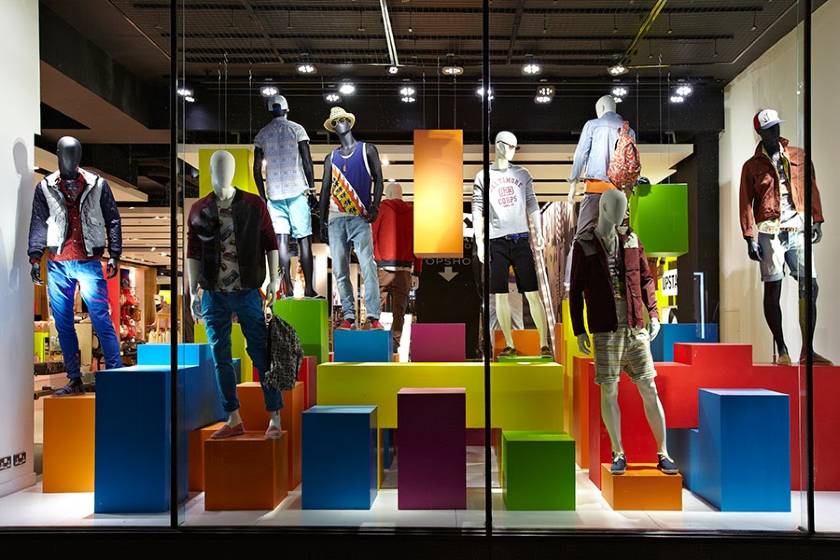
A vibrant window display uses primary colors to create a cohesive and colorful scene. (Source: Mall Xplorer)
Know Your Target Audience
For your storytelling to be effective, you have to know who you are directing your story to—your target audience.
Your target audience is the demographic group that shops at your store or a group you think your brand and products would appeal to.
For example, at my boutique, we sold modern bohemian-style clothing at a relatively low price point. We knew we were not going to appeal to men or women going for luxury labels. Instead, we catered our message to women aged 18–45 with more laid-back lifestyles and clothing tastes. This meant displaying scenes of park strolls or casual brunches in our window displays as we knew that those stories would be more appealing to the women who would actually shop in our store.
To determine your target audience, you will first want to observe who shops at your store and then consider what other groups would be interested in your products. The Home Depot, for example, has gone so far as to name the target market the DIYers, or do-it-yourselfers, those who take on home improvement projects themselves.
Then, you will want to think about what stories would appeal to that group. In the case of The Home Depot, its target audience are people who are willing to get down and dirty to get a DIY job done. All of its messaging, then, focuses on telling stories of a weekend of landscaping projects or bathroom renovations, and the sense of personal satisfaction that comes with doing those jobs yourself.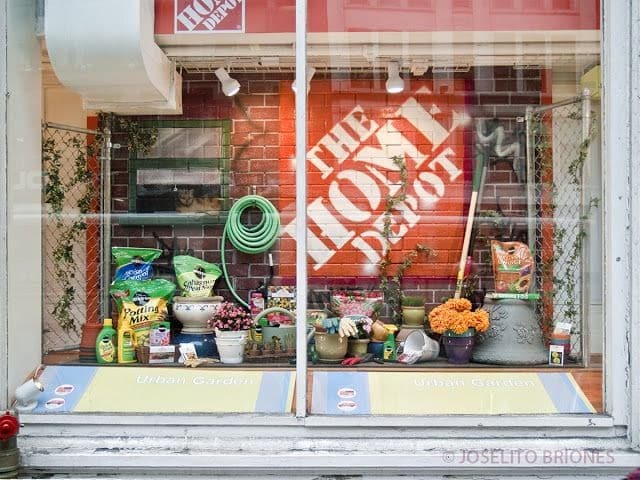
Home Depot displays the remnants of a DIY landscaping project. (Source: Home Depot)
Craft a Specific Message
When telling your story, you want to be sure you are specific so that your message does not become muddled to your audience and that they are able to identify the story you are telling. This will also make your job easier, as you won’t be trying to fit too many elements or complexities into your window space.
For example, trying to tell a story of winter is much more difficult than telling a story of a snowstorm, although they will both invoke many of the same sentiments and aesthetics.
A window display shows a person traveling through a winter storm landscape. (Source: RetailBiz)
A helpful tip for deciding on a specific story is to start with a theme, and then move into something more specific from there. For example, say your theme is travel. From there, your story could be a tropical cruise or a ski lodge retreat. Or, say your theme is Halloween, and then you move to something like trick or treating or a seance.
Stay on Brand
You want to be sure that your store window display speaks to your brand. This will ensure that the impression your display leaves is in line with what your business stands for and that people have a good idea of what to expect from your store. This will also help you hone in on your target audience, as your brand voice will speak to those interested in your offerings.
A fun window display reflects this youthful and funky brand. (Source: Boutique Window)
Additionally, if your display is incongruous with your brand, it will seem misleading to customers and will make them distrustful of your business.
For example, going back to my store, say our window displays were to feature mannequins carrying designer handbags and enjoying tea at a fancy table setting. This would not only deter our target audience but would also create a false impression of what we offer. Customers would be confused and likely annoyed by the misleading window displays and would not want to visit my store again.
Consider your brand, what it stands for, and how you can reflect this in your store window displays. This will ensure that you are attracting the right customers and are not being misleading.
Keep It Simple
While you want your display to be exciting and draw people’s attention, too much clutter is likely to overwhelm and even deter passersby. Don’t try to do too much in your display or you’ll just end up with something busy and unfocused.
For this point, I like to follow a rule of three:
- First, you should have a subject, or the main focus of the display
- Second, a background, or the backdrop for the display
- Third, accessory items, or supporting pieces that add depth.
You can choose to use all three of these elements, or you can stop after the first or second. You should never, however, have more than one subject. Otherwise, the display loses focus and becomes too busy.
Let’s look at an example. In this display below, the subject is the figure, outfitted in winter gear. The backdrop is the winter forest landscape and lights. And, the accessories are the firewood and bird figure. By sticking to the rule of three, this window display creates interest and intrigue without cluttering the space.
A store window balances a focal point, background, and accessory items. (Source: Squidoo)
Take Inspiration From Others
If you find yourself stuck at any point in the process of creating your store window displays, some of the best inspiration you can find comes from your neighbors and competitors. Take a walk around your block or your closest mall, and look at what others are doing.
Pay attention to what captures your attention. What elements are most exciting to your eye? It might be a light display, window decals advertising a sale, or an elaborate scene.
You can also observe the displays that are stopping other shoppers. Look for where others are pausing and looking. Pay attention to what stores people are drawn to and what displays are translating to increased foot traffic.
One final tip—look at the merchandising leaders in your industry and take notes on what they are doing to make themselves stand out. Luxury and large corporate retailers have massive budgets and research departments to guide their merchandising initiatives, so look to them to see what the best strategies are for creating effective store window displays.
Anthropologie, a major fashion retailer, is known for creating some of the most inventive and elaborate store window displays in retail. (The Steen Style)
Consider the Season
You want to ensure that your window displays are timely and make sense with the current season or holiday. This will help your window’s story seem relevant to your shoppers and will let them know that you are prepared with seasonally appropriate merchandise.
Seasonal window displays are also a great opportunity to advertise products that will only be available during the season in question, and will help you promote those items so you aren’t left with extras when the season ends.
Holiday window displays are another important seasonal consideration. I am sure you have seen pictures of New York City department stores during the holiday season and the elaborate displays they create to invoke feelings of holiday cheer and to promote holiday shopping. These displays are over the top for a reason. During the holiday season, there are huge profits to be made, and an elaborate window display will help you capitalize on those sales.
Did you know?
In different areas of retail, 20%–35% of annual sales are made during the holiday season, and this past year, holiday retail sales hit $876 billion, a number that is on an upward trajectory.
You can learn more about creating holiday window displays from our article.
A holiday window display features holiday party outfits and a festive setting.
2. Create a Focal Point
Once you have a story planned out, anchor that story with a focal point. Your focal point is the subject of your window display and the aspect of your display that customers will notice first and pay the most attention to. The rest of your display—from your background to accent pieces—will be built around this point, so be sure you are placing it wisely and making it bold enough to carry weight.
Here are some tips to help you create a stunning and eye-catching focal point:
Stay at Eye-Level
The most important part of placing your focal point will be making sure that it is in the line of sight of people passing by your store window display. This will not only ensure that your focal point is seen and appreciated but will also promote window shopping.
To accomplish creating an eye-level display, you will need to put yourself in the shoes of your customers and take a step outside your store to see exactly where eye level is. Additionally, as you place your focal point, you will want to continue to monitor how it looks from the outside, and play with the best positioning for packing a visual punch.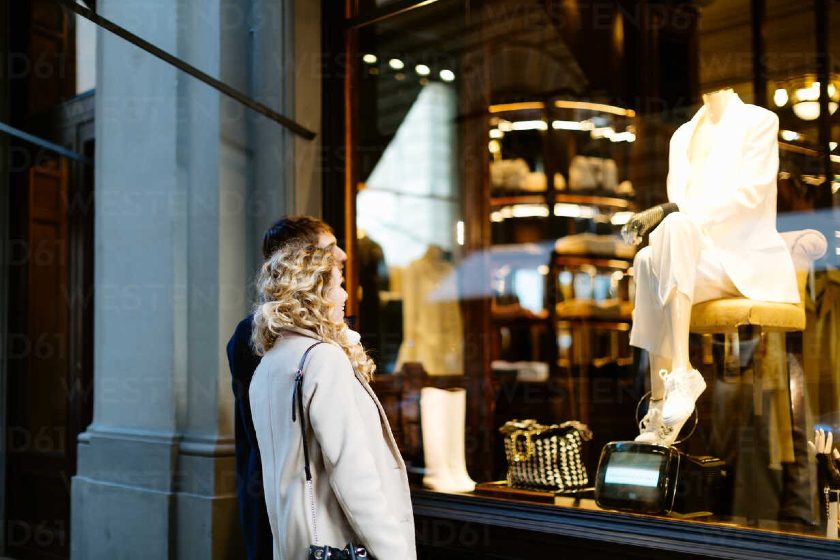
A couple admires a well-positioned window display. (Source: Westend61)
Use Adequate Lighting
Lighting can evoke an ambiance, highlight products, and create a dramatic setting for your store window display. Being strategic with lighting can pay dividends in directing onlookers’ eyes to where you want them to go and can play a major role in getting people to stop and admire your display.
Consider using spotlights to create a dramatic lighting scheme around your focal point. You might also want to play with contrast or create areas of high and low exposure that will help guide customers’ eyes through your display and draw their attention to key areas.
Your window displays are a great place to play with dramatic lighting schemes that may not work in other areas of your store. Use colorful or overly bright lights, or use your lighting as a prop in the display. Be bold with your lighting choices, and watch the eyes (and foot traffic) follow.
Check out our article for more information on creating your store lighting plan.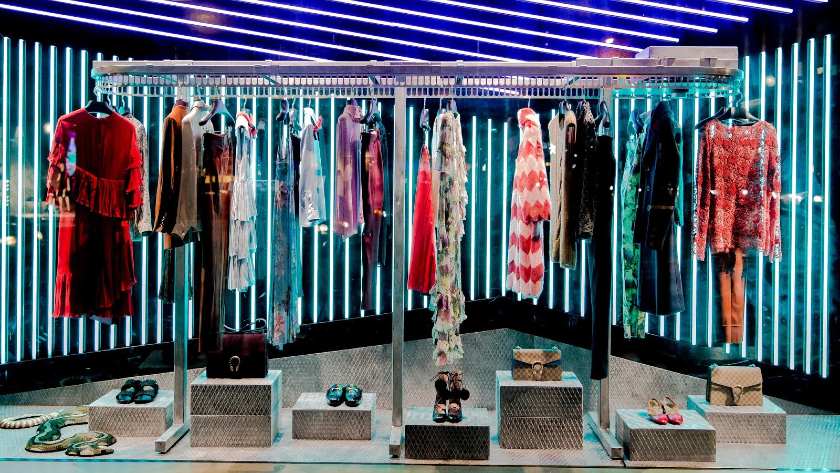
Vibrant LED lights create a dramatic, and eye-catching window display. (Source: FashionNetwork.com)
Be Bold
More than ever, your shoppers are distracted. To combat this, you need to be bold with your focal point, and the entirety of your window display.
As we have discussed, window displays are one the best tools for turning an onlooker into a customer, but you have to capture their attention first. The key here is definitely innovation—the easiest way to catch people’s eyes is with something they have never seen before.
Another tip is to take a walk around your block to get a sense of what your competition is. Your goal should be to be the boldest window in your area so that you become the distraction from your competitors, not the other way around.
Take a look at this article for examples of some of the best window displays and what makes them great for more on how you can create something striking and innovative in your business.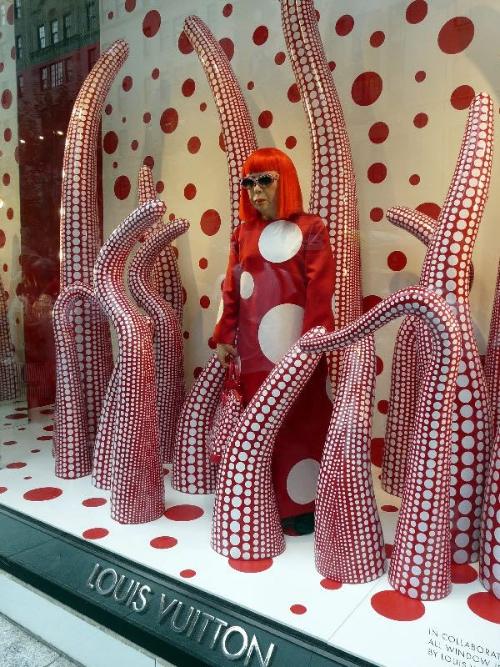
A bold window display combines fine art and fashion. (Source: Pinterest)
3. Build Depth
In addition to creating a focal point in your store window, you will also want to add additional elements for depth in your display. This includes a backdrop, props, or even interactive components. These features will help to make your window more interesting to onlookers, promote greater engagement with your display, and ultimately drive more people into your store.
Here are a few guidelines for adding depth to your store window display:
Shoot for Balance
When assembling the different parts of your display, you will want to be sure you are creating balance. An unbalanced display will be displeasing to the eye, whereas one that is harmonious will be pleasing and will make it easier for your story or emotional intent to translate to customers.
One tip is to place darker and heavier items near the bottom of your display, and to place lighter and more colorful elements near the top. This will prevent your display from feeling top-heavy and will help draw the eye up and through its entirety.
Additionally, try to spread out your background elements evenly—do not leave one side full and busy and the other barren. Humans are more attracted and inclined to look at scenes that are symmetrical, as symmetrical objects and images are recognized more easily and mimic the world around us.
The best way to ensure that you are achieving balance and a sense of symmetry in your display is to take a step outside and take a bird’s eye view of what you are creating.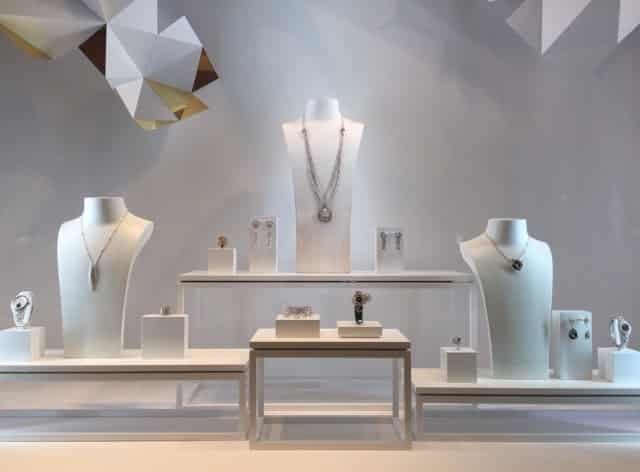
A jewelry store creates a well-balanced window display to showcase its products.
(Source: Zen Merchandiser)
Avoid Overfilling
It is tempting to fill your display with all your best products to showcase as much as possible. This will, however, drive the eyes away from your display and will leave the impression that your brand is cluttered and disorganized.
Choose one or two products or sets of products when creating your display, then seek to fill the rest of the space with decorative elements. This will create a spotlight on the products that are featured, and the decorative elements will promote visual engagement with those products.
Another tip is to take a look at your display once it is assembled and ask yourself whether there is anything that you can remove that would not take away from the display. This will help you parse out unnecessary and distracting elements. Don’t be afraid of minimalism—sometimes it’s all you need to create something stunning.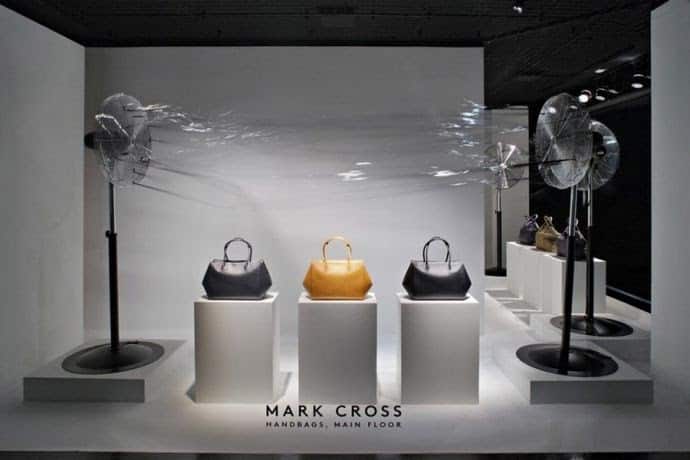
A minimalist window display draws attention to key products and avoids clutter. (Source: CreativeNYC)
Try Interactive Elements
One of the best ways to promote engagement with your window display (and thus drive foot traffic) is through interactive elements. This might look like a QR code that people can scan to sign up for your emails, a screen-printed social media handle on the outside of your window, videos that customers can scroll through, or even augmented reality technologies.
For example, the home goods brand Clas Ohlson installed large screens in its store windows that customers could control with their phones. People could scroll through its product catalogs, see the latest deals, and even make purchases right there. Because its display was so innovative, it was able to attract new customers and create relationships with shoppers who didn’t even step foot in its store.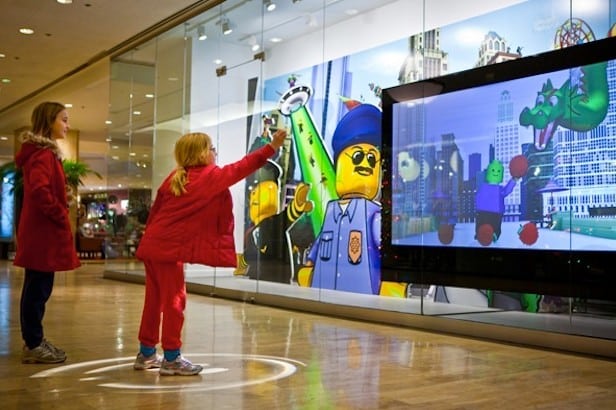
A window display at a LEGO store allows shoppers to control a figure on the screen with their own body movement. (Source: This is Retail)
4. Review Your Display
Once your story is told and all the elements are in place, it is time to review your display and admire your handiwork. This is not, however, the end of your window display journey as you should continue to update your display and monitor its performance so that it will improve and keep the customers engaged.
Follow these best practices for keeping your display up to date and exciting through the months and years:
Change Your Display Frequently
As a rule of thumb, update your window displays at least every six to eight weeks. This will ensure it stays timely and up to date with the seasons, continuing to engage repeat customers.
When evaluating how often to change your window displays, consider the frequency with which people are visiting your store. Retailers who see more frequent visits from shoppers, like convenience stores, grocers, and fast fashion shops, should consider changing their window displays more often.
If you are changing up your window displays more frequently, this can look like weekly refreshes and biweekly overhauls. You do not have to do a complete revamp every time, but strive to keep things fresh so that customers always have something new to catch their eyes and strike interest.
Invest in Versatile Props
Window displays do not have to be overly costly, and one of the best ways to save money is to invest in props that can be used over and over again in different ways. For example, clothing retailers often invest in mannequins because they can put them into different outfits and use them in many different ways without any need for replacements.
Additional props to consider investing in are product stands, display screens, LED lights with color customization, and large pictures that you can rotate in and out.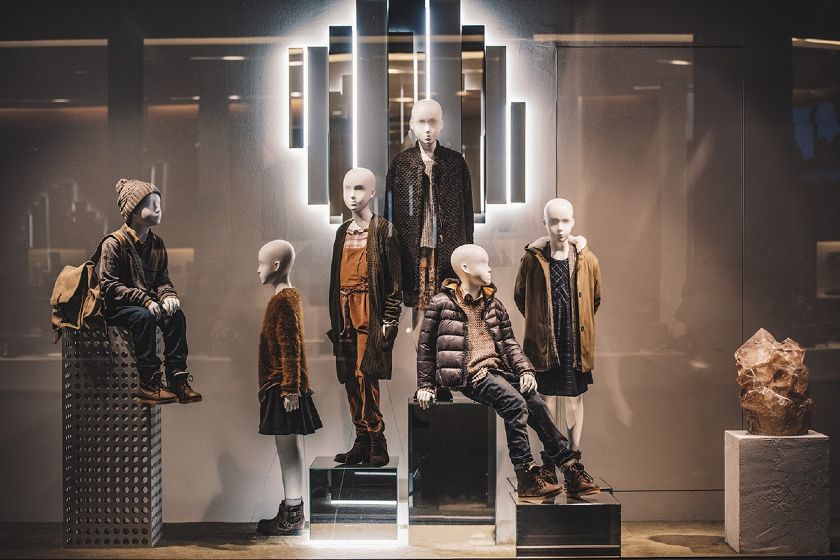
These mannequins are dressed for the season, and can easily be changed for the months to come. (Source: Foko Retail)
Analyze Performance
When you are analyzing how well your window display is performing, the main thing that you will want to look at is your foot traffic. To start, you will want to track the number of people who enter your store before and after your display is installed. Then, you can track how that traffic increases or decreases as you try different display methods so you can determine which strategies are most effective.
Foot traffic counting methods include the manual click counter and infrared sensors. For the manual counter, an associate or yourself tracks the number of people who visit your store by clicking a button every time someone comes inside. Then, you use the hourly and daily tallies to determine if traffic has increased. Uline offers a great handheld option for manual tally tracking.
For an automated option, you can use people counter sensors. These sensors electronically track whenever someone passes through your entryway, and then transmit the tallies to your computer or point-of-sale system. Dōr is a popular people counting sensor for retailers.
Compete With Your Neighbors
If your store is in a large shopping center or around other shops, you are competing for attention with your neighbors. Say you decide to set your store window up with a few subdued mannequins and minimal decor, but your neighbors have chosen to go with a brightly lit display with interactive features and bright colors. In this scenario, your window display would fall into the background, and customers’ eyes would be too distracted by your neighbors to notice your store.
To avoid this issue and ensure that you are the one catching eyes, you will want to take a walk around your neighborhood and take inventory of your competitors. Try to put yourself in the shoes of your customers. Would your display catch your eyes, or would another storefront be more enticing? Seek to be the best display on your street so that you can capitalize on your local foot traffic.
Shoppers walk through a shopping center full of stores with competing window displays. (Source: Visit Philadelphia)
Bottom Line
Store window displays are one of the most important parts of your business. They are the first impression you give to customers, tell a story of who you are, and have the power to drive foot traffic, and ultimately, sales. Setting up your window display does not have to be intimidating, and you can make an effective display by focusing on the steps and best practices outlined above.
